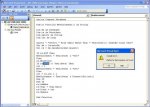andrewneal
US Air Force User
- Local time
- Today, 12:36
- Joined
- Sep 19, 2006
- Messages
- 34
I am working on a report that gets printed once or twice a week. The manager would like this report to print the year and the increment number (for that year) on the report. For instance, when the first one for 2007 is printed the increment number will look something like 2007001 and the second will look like 2007002. This increment would only be the number of times they have printed/viewed this report for that year and would need to be automatically refreshed on the 1st of each year.
I thought about making a table that has this increment count in it. Then write a code that will update that table with a number "1" each time the report is printed/viewed. I would imagine I could write this into the report's "on open" function, but I would have no idea how to do this. I could then build a query that counts the total numbers in this table and put that query number in the report.
Any help would be much appreciated!
I thought about making a table that has this increment count in it. Then write a code that will update that table with a number "1" each time the report is printed/viewed. I would imagine I could write this into the report's "on open" function, but I would have no idea how to do this. I could then build a query that counts the total numbers in this table and put that query number in the report.
Any help would be much appreciated!


